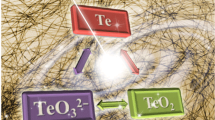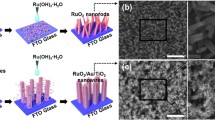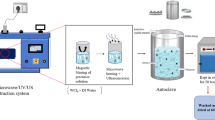Abstract
Recently, the synthesis of ultrathin nanostructures has attracted increasing interest because of their unique structure and properties. In this work, we report the synthesis of sub-2.0-nm Ru and composition-tunable RuPt nanowire networks using an environmentally friendly aqueous method. The structures were characterized using transmission electron microscopy (TEM), high-resolution TEM, X-ray diffraction (XRD), and energy-dispersive X-ray (EDX) spectroscopy. Moreover, the combined utilization of sodium n-dodecyl sulfate and potassium fluoride was determined to play a key role in the formation of these ultrathin nanostructures. The electrocatalytic properties of the sub-2.0-nm RuPt nanowire networks were investigated for methanol oxidation in an acidic medium. The nanostructures displayed composition-dependent properties, and compared with commercial Ru50Pt50/C, the as-synthesized Ru56Pt44 ultrathin nanowire network exhibited enhanced stability.

Similar content being viewed by others
References
Zahmakiran, M.; Tonbul, Y.; Özkar, S. Ruthenium(0) nanoclusters stabilized by a nanozeolite framework: Isolable, reusable, and green catalyst for the hydrogenation of neat aromatics under mild conditions with the unprecedented catalytic activity and lifetime. J. Am. Chem. Soc. 2010, 132, 6541–6549.
Anderson, R.; Griffin, K.; Johnston, P.; Alsters, P. L. Selective oxidation of alcohols to carbonyl compounds and carboxylic acids with platinum group metal catalysts. Adv. Synth. Catal. 2003, 345, 517–523.
Fellay, C.; Dyson, P. J.; Laurenczy, G. A viable hydrogenstorage system based on selective formic acid decomposition with a ruthenium catalyst. Angew. Chem., Int. Ed. 2008, 47, 3966–3968.
Xiao, C. X.; Cai, Z. P.; Wang, T.; Kou, Y.; Yan, N. Aqueousphase Fischer–Tropsch synthesis with a ruthenium nanocluster catalyst. Angew. Chem., Int. Ed. 2008, 47, 746–749.
Osada, M.; Sato, T.; Watanabe, M.; Adschiri, T.; Arai, K. Low-temperature catalytic gasification of lignin and cellulose with a ruthenium catalyst in supercritical water. Energy Fuels 2004, 18, 327–333.
Nishibayashi, Y.; Iwai, S.; Hidai, M. Bimetallic system for nitrogen fixation: Ruthenium-assisted protonation of coordinated N2 on tungsten with H2. Science 1998, 279, 540–542.
Kowal, A.; Li, M.; Shao, M.; Sasaki, K.; Vukmirovic, M. B.; Zhang, J.; Marinkovic, N. S.; Liu, P.; Frenkel, A. I.; Adzic, R. R. Ternary Pt/Rh/SnO2 electrocatalysts for oxidizing ethanol to CO2. Nat. Mater. 2009, 8, 325–330.
Yin, A.-X.; Liu, W.-C.; Ke, J.; Zhu, W.; Gu, J.; Zhang, Y.-W.; Yan, C.-H. Ru nanocrystals with shape-dependent surface-enhanced Raman spectra and catalytic properties: Controlled synthesis and DFT calculations. J. Am. Chem. Soc. 2012, 134, 20479-20489.
Nosheen, F.; Zhang, Z. C.; Xiang, G. L.; Xu, B.; Yang, Y.; Saleem, F.; Xu, X. B.; Zhang, J. C.; Wang, X. Threedimensional hierarchical Pt–Cu superstructures. Nano Res. 2015, 8, 832–838.
Zheng, F. L.; Wong, W.-T.; Yung, K.-F. Facile design of Au@Pt core–shell nanostructures: Formation of Pt submonolayers with tunable coverage and their applications in electrocatalysis. Nano Res. 2014, 7, 410–417.
Alayoglu, S.; Nilekar, A. U.; Mavrikakis, M.; Eichhorn, B. Ru–Pt core–shell nanoparticles for preferential oxidation of carbon monoxide in hydrogen. Nat. Mater. 2008, 7, 333–338.
Zhang, Q.; Guo, X.; Liang, Z. X.; Zeng, J. H.; Yang, J.; Liao, S. J. Hybrid PdAg alloy–Au nanorods: Controlled growth, optical properties and electrochemical catalysis. Nano Res. 2013, 6, 571–580.
Xiang, J.; Li, P.; Chong, H. B.; Feng, L.; Fu, F. Y.; Wang, Z.; Zhang, S. L.; Zhu, M. Z. Bimetallic Pd–Ni core–shell nanoparticles as effective catalysts for the Suzuki reaction. Nano Res. 2014, 7, 1337–1343.
Wang, Y.; Ren, J. W.; Deng, K.; Gui, L. L.; Tang, Y. Q. Preparation of tractable platinum, rhodium, and ruthenium nanoclusters with small particle size in organic media. Chem. Mater. 2000, 12, 1622–1627.
Pan, C.; Pelzer, K.; Philippot, K.; Chaudret, B.; Dassenoy, F.; Lecante, P.; Casanove, M. J. Ligand-stabilized ruthenium nanoparticles: Synthesis, organization, and dynamics. J. Am. Chem. Soc. 2001, 123, 7584–7593.
Yan, X. P.; Liu, H. F.; Liew, K. Y. Size control of polymerstabilized ruthenium nanoparticles by polyol reduction. J. Mater. Chem. 2001, 11, 3387–3391.
Viau, G.; Brayner, R.; Poul, L.; Chakroune, N.; Lacaze, E.; Fié vet-Vincent, F.; Fiévet, F. Ruthenium nanoparticles: Size, shape, and self-assemblies. Chem. Mater. 2003, 15, 486–494.
Tsukatani, T.; Fujihara, H. New method for facile synthesis of amphiphilic thiol-stabilized ruthenium nanoparticles and their redox-active ruthenium nanocomposite. Langmuir 2005, 21, 12093–12095.
Zhai, H. T.; Wang, R. R.; Wang, W. Q.; Wang, X.; Cheng, Y.; Shi, L. J.; Liu, Y. Q.; Sun, J. Novel fabrication of copper nanowire/cuprous oxidebased semiconductor-liquid junction solar cells. Nano Res. 2015, 8, 3205–3215.
Yuan, J. K.; Liu, X. G.; Akbulut, O.; Hu, J. Q.; Suib, S. L.; Kong, J.; Stellacci, F. Superwetting nanowire membranes for selective absorption. Nat. Nanotechnol. 2008, 3, 332–336.
Nerowski, A.; Opitz, J.; Baraban, L.; Cuniberti, G. Bottom-up synthesis of ultrathin straight platinum nanowires: Electric field impact. Nano Res. 2013, 6, 303–311.
Cheng, H.; Lu, Z. G.; Deng, J. Q.; Chung, C. Y.; Zhang, K. L.; Li, Y. Y. A facile method to improve the high rate capability of Co3O4 nanowire array electrodes. Nano Res. 2010, 3, 895–901.
Yuan, Q.; Zhou, Z. Y.; Zhuang, J.; Wang, X. Seed displacement, epitaxial synthesis of Rh/Pt bimetallic ultrathin nanowires for highly selective oxidizing ethanol to CO2. Chem. Mater. 2010, 22, 2395–2402.
Yang, S. C.; Hong, F.; Wang, L. Q.; Guo, S. W.; Song, X. P.; Ding, B. J.; Yang, Z. M. Ultrathin Pt-based alloy nanowire networks: Synthesized by CTAB assistant twophase water-chloroform micelles. J. Phys. Chem. C 2010, 114, 203–207.
Hu, S.; Liu, H. L.; Wang, P. P.; Wang, X. Inorganic nanostructures with sizes down to 1 nm: A macromolecule analogue. J. Am. Chem. Soc. 2013, 135, 11115–11124.
Huang, X. Q.; Zhao, Z. P.; Chen, Y.; Chiu, C.-Y.; Ruan, L. Y.; Liu, Y.; Li, M. F.; Duan, X. F.; Huang, Y. High density catalytic hot spots in ultrafine wavy nanowires. Nano Lett. 2014, 14, 3887–3894.
Scofield, M. E.; Koenigsmann, C.; Wang, L.; Liu, H. Q.; Wong, S. S. Tailoring the composition of ultrathin, ternary alloy PtRuFe nanowires for the methanol oxidation reaction and formic acid oxidation reaction. Energy Environ. Sci. 2015, 8, 350–363.
Song, Y. J.; Garcia, R. M.; Dorin, R. M.; Wang, H. R.; Qiu, Y.; Coker, E. N.; Steen, W. A.; Miller, J. E.; Shelnutt, J. A. Synthesis of platinum nanowire networks using a soft template. Nano Lett. 2007, 7, 3650–3655.
Teng, X. W.; Han, W.-Q.; Ku, W.; Hücker, M. Synthesis of ultrathin palladium and platinum nanowires and a study of their magnetic properties. Angew. Chem., Int. Ed. 2008, 47, 2055–2058.
Halder, A.; Ravishankar, N. Ultrafine single-crystalline gold nanowire arrays by oriented attachment. Adv. Mater. 2007, 19, 1854–1858.
Koenigsmann, C.; Semple, D. B.; Sutter, E.; Tobierre, S. E.; Wong, S. S. Ambient synthesis of high-quality ruthenium nanowires and the morphology-dependent electrocatalytic performance of platinum-decorated ruthenium nanowires and nanoparticles in the methanol oxidation reaction. ACS Appl. Mater. Interfaces 2013, 5, 5518–5530.
Teng, X. W.; Feygenson, M.; Wang, Q.; He, J. Q.; Du, W. X.; Frenkel, A. I.; Han, W. Q.; Aronson, M. Electronic and magnetic properties of ultrathin Au/Pt nanowires. Nano Lett. 2009, 9, 3177–3184.
Hong, X.; Tan, C.; Chen, J.; Xu, Z.; Zhang, H. Synthesis, properties and applications of one- and two-dimensional gold nanostructures. Nano Res. 2015, 8, 40–55.
Huo, Z. Y.; Tsung, C. K.; Huang, W. Y.; Zhang, X. F.; Yang, P. D. Sub-two nanometer single crystal Au nanowires. Nano Lett. 2008, 8, 2041–2044.
Lu, X. M.; Yavuz, M. S.; Tuan, H.; Korgel, B. A.; Xia, Y. N. Ultrathin gold nanowires can be obtained by reducing polymeric strands of oleylamine-AuCl complexes formed via aurophilic interaction. J. Am. Chem. Soc. 2008, 130, 8900–8901.
Huo, Z. Y.; Tsung, C. K.; Huang, W. Y.; Fardy, M.; Yan, R. X.; Zhang, X. F.; Li, Y. D.; Yang, P. D. Self-organized ultrathin oxide nanocrystals. Nano Lett. 2009, 9, 1260–1264.
Peng, X. G.; Manna, L.; Yang, W. D.; Wickham, J.; Scher, E.; Kadavanich, A.; Alivisatos, A. P. Shape control of CdSe nanocrystals. Nature 2000, 404, 59–61.
Wang, D. S.; Peng, Q.; Li, Y. D. Nanocrystalline intermetallics and alloys. Nano Res. 2010, 3, 574–580.
Liu, L. P.; Zhuang, Z. B.; Xie, T.; Wang, Y. G.; Li, J.; Peng, Q.; Li, Y. D. Shape control of CdSe nanocrystals with zinc blende structure. J. Am. Chem. Soc. 2009, 131, 16423–16429.
Xiong, Y. J.; Washio, I.; Chen, J. Y.; Cai, H. G.; Li, Z. Y.; Xia, Y. N. Poly(vinyl pyrrolidone): A dual functional reductant and stabilizer for the facile synthesis of noble metal nanoplates in aqueous solutions. Langmuir 2006, 22, 8563–8570.
Ponrouch, A.; Garbarino, S.; Pronovost, S.; Taberna, P.-L.; Simon, P.; Guay, D. Electrodeposition of arrays of Ru, Pt, and PtRu alloy 1D metallic nanostructures. J. Electrochem. Soc. 2010, 157, K59-K65.
Zhang, Y. W.; Grass, M. E.; Kuhn, J. N.; Tao, F.; Habas, S. E.; Huang, W. Y.; Yang, P. D.; Somorjai, G. A. Highly selective synthesis of catalytically active monodisperse rhodium nanocubes. J. Am. Chem. Soc. 2008, 130, 5868–5869.
Tsung, C. K.; Kuhn, J. N.; Huang, W. Y.; Aliaga, C.; Hung, L. I.; Somorjai, G. A.; Yang, P. D. Sub-10 nm platinum nanocrystals with size and shape control: Catalytic study for ethylene and pyrrole hydrogenation. J. Am. Chem. Soc. 2009, 131, 5816–5822.
Yuan, Q.; Zhuang, J.; Wang, X. Single-phase aqueous approach toward Pd sub-10 nm nanocubes and Pd–Pt heterostructured ultrathin nanowires. Chem. Commun. 2009, 6613–6615.
Huang, X. Q.; Zheng, N. F. One-pot, high-yield synthesis of 5-fold twinned Pd nanowires and nanorods. J. Am. Chem. Soc. 2009, 131, 4602–4603.
Tang, Z. Y.; Kotov, N. A.; Giersig, M. Spontaneous organization of single CdTe nanoparticles into luminescent nanowire. Science 2002, 297, 237–240.
Whang, D.; Jin, S.; Wu, Y.; Lieber, C. M. Large-scale hierarchical organization of nanowire arrays for integrated nanosystems. Nano Lett. 2003, 3, 1255–1259.
Häglund, J.; Fernández Guillermet, A.; Grimvall, G.; Körling, M. Theory of bonding in transition-metal carbides and nitrides. Phys. Rev. B 1993, 48, 11685–11691.
Chen, A. C.; Holt-Hindle, P. Platinum-based nanostructured materials: Synthesis, properties, and applications. Chem. Rev. 2010, 110, 3767–3804.
Green, C. L.; Kucernak, A. Determination of the platinum and ruthenium surface areas in platinum-ruthenium alloy electrocatalysts by underpotential deposition of copper. I. Unsupported catalysts. Phys. Chem. B 2002, 106, 1036–1047.
Jiang, J. H.; Kucernak, A. Mesoporous microspheres composed of PtRu alloy. Chem. Mater. 2004, 16, 1362–1367.
Herrero, E.; Franaszczuk, K.; Wieckowski, A. Electrochemistry of methanol at low index crystal planes of platinum: An integrated voltammetric and chronoamperometric study. Phys. Chem. 1994, 98, 5074–5083.
Author information
Authors and Affiliations
Corresponding authors
Electronic supplementary material
Rights and permissions
About this article
Cite this article
Zhao, W., Huang, D., Yuan, Q. et al. Sub-2.0-nm Ru and composition-tunable RuPt nanowire networks. Nano Res. 9, 3066–3074 (2016). https://doi.org/10.1007/s12274-016-1189-4
Received:
Revised:
Accepted:
Published:
Issue Date:
DOI: https://doi.org/10.1007/s12274-016-1189-4




